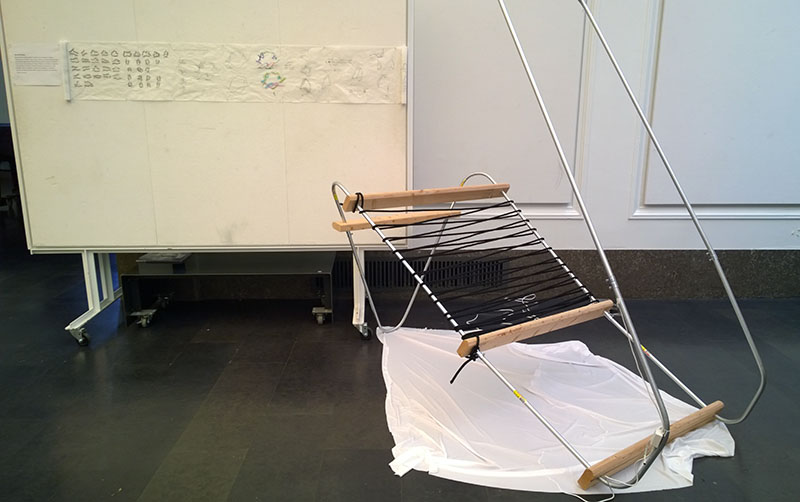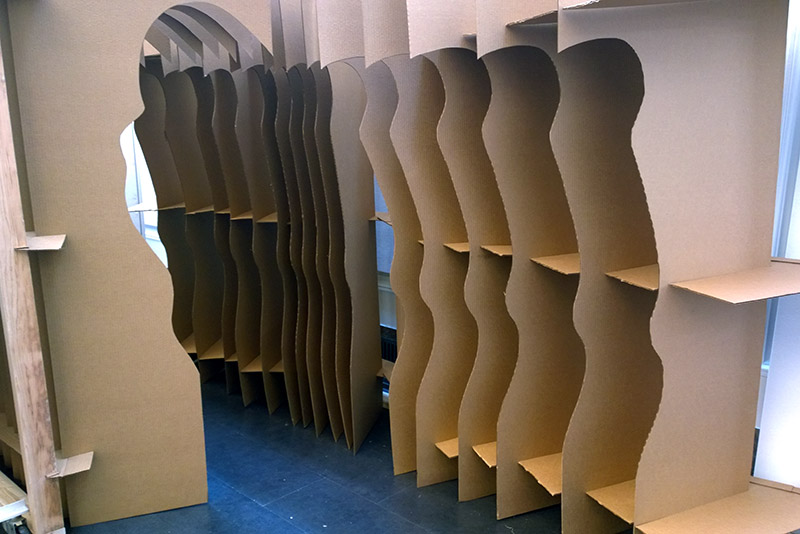By Natali Ashigova
For a few hours on an afternoon in mid-February, hospitality installations filled the second floor gallery in Vol Walker Hall. The projects in this temporary display were created by 17 interior design students in the Fay Jones School, who were presenting their works as part of a hospitality design project conducted by Jennifer Webb, an associate professor of interior design.
Students were inspired by everyday events in hotel settings, and each student explored the activities, feelings and senses evoked by these activities, Webb said.
“Whether it is a bad night sleep on a bed that is too hard; it’s a hug from someone you have been waiting to see for years; it’s packing a suitcase that won’t close or that springs open when you want to zip it; it’s dancing at a special occasion,” Webb said. “We have students that wanted to explore affairs, physical intimacy between partners, aspects of falling in love.”
 In order to create their installations, students used a wide range of materials — wood, chicken wire, metal bolts, cardboard, paper, fabric. This project was especially important and useful for students, as they had the chance to work with real materials, Webb said. Although the students each used different materials, they still were able to learn how to work with various materials by observing their peers working with them.
In order to create their installations, students used a wide range of materials — wood, chicken wire, metal bolts, cardboard, paper, fabric. This project was especially important and useful for students, as they had the chance to work with real materials, Webb said. Although the students each used different materials, they still were able to learn how to work with various materials by observing their peers working with them.
“One of the things I emphasize in this studio is construction, detailing and understanding how things fit together. Until you build something, you don’t really understand the implications. You can build models all day, but holding something together with glue is very different from holding something together with nuts and bolts, and screws, and joinery,” Webb said.
One of the first installations that people could see when they entered the gallery was created by Jac Kerr, who worked with the concept of packing and unpacking a suitcase. A row of large, wooden frames connected by a rope represented a suitcase, which people could try to close and open in the gallery.
“I wanted to focus on the range of emotions of people packing and unpacking their suitcases. I really wanted something that would be interactive as well, something people can be a part of,” she said.
 Another attention-catching installation near the “suitcase” was a bar depicted with a wall of small metal bolts. If you leaned against the wall while standing at the bar, people who were behind the wall would see the silhouette of your body.
Another attention-catching installation near the “suitcase” was a bar depicted with a wall of small metal bolts. If you leaned against the wall while standing at the bar, people who were behind the wall would see the silhouette of your body.
When creating this installation, Natalie Banister was thinking about people who go to the bar in a hotel to meet someone new.
“(People) tend to alter the way others will see them by fixing themselves to where they think the back of themselves looks more approachable,” Banister wrote in the explanatory note attached to this installation.
 While standing at the bar, visitors eventually notice someone sleeping on a white bed covered with a white blanket. That papier-mâché figure warmed by lights under the blanket was a project by Brianna Jones-Mosby, called “A Place Within a Space.” People could come and lie down next to the anonymous person, hug its form and feel its warmth.
While standing at the bar, visitors eventually notice someone sleeping on a white bed covered with a white blanket. That papier-mâché figure warmed by lights under the blanket was a project by Brianna Jones-Mosby, called “A Place Within a Space.” People could come and lie down next to the anonymous person, hug its form and feel its warmth.
“It is about finding your place in that leftover space when you share a bed with someone,” Jones-Mosby said.
Next to the bedding, there was a white stand with a half of a mirror and white tracks of feet on the ground as if reflected by the open space between them. Taegan Lovelace’s work was intended to represent the moment when a couple gets married in a hotel and becomes a singular entity.
“When you are walking down the aisle to get married, everybody is watching you,” Lovelace said. “But once you get to the area where your other half is, it’s like you two are the only people in the world.”
 As visitors walked through the gallery, they could see many other hospitality projects — a big, black box filled with tape, which evoked the feeling of being in a crowded elevator, as well as a silhouette of a dancer in a white dress, a shower cabin and other installations.
As visitors walked through the gallery, they could see many other hospitality projects — a big, black box filled with tape, which evoked the feeling of being in a crowded elevator, as well as a silhouette of a dancer in a white dress, a shower cabin and other installations.
Each of the installations had an explanatory note, often with pictures on it, so that everyone could understand the meaning and purpose of the work. These projects enabled students to understand hotels on a more intimate level and to begin crafting ideas for their own solutions, Webb said. Space is a sensory experience, and it is up to the designer to make a guest’s visit a positive one.


